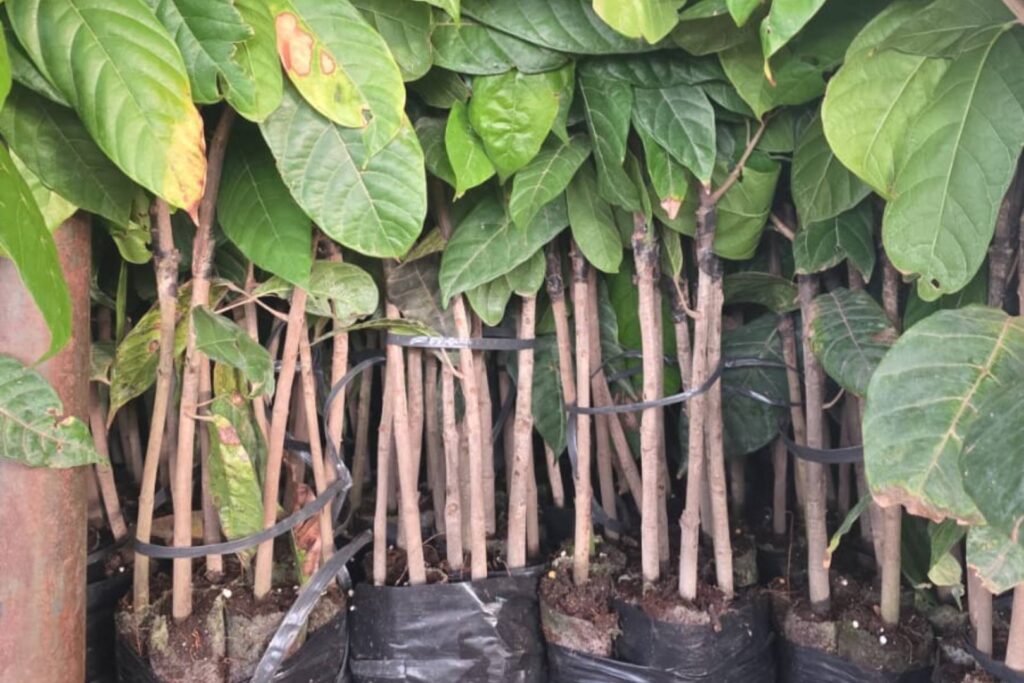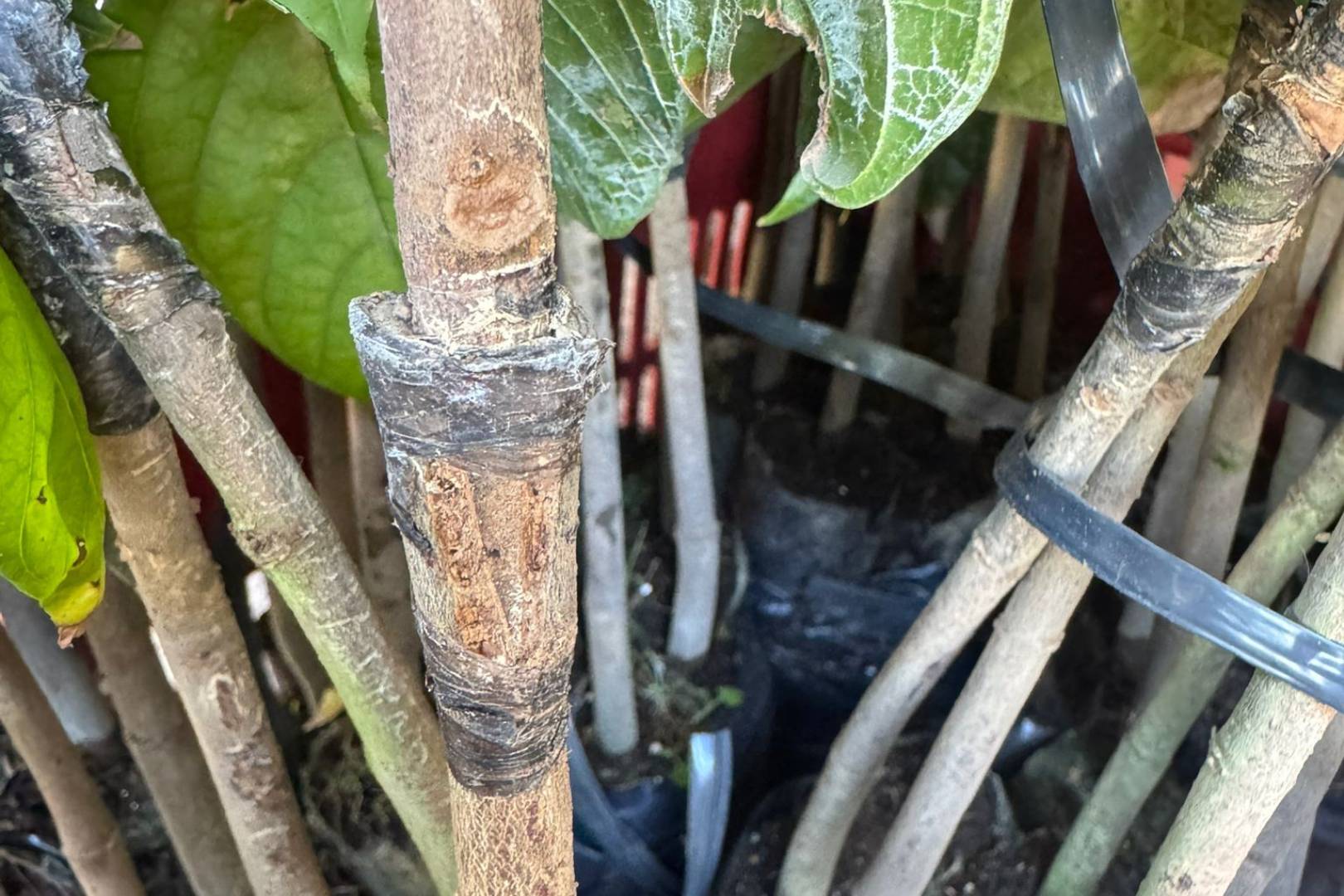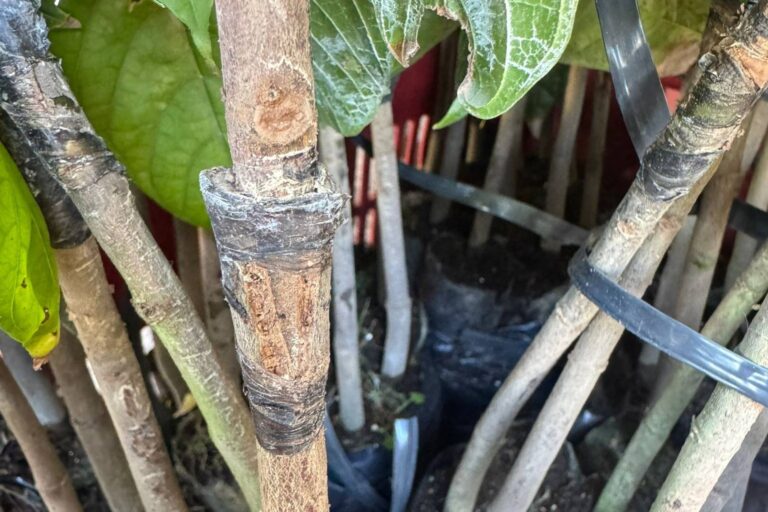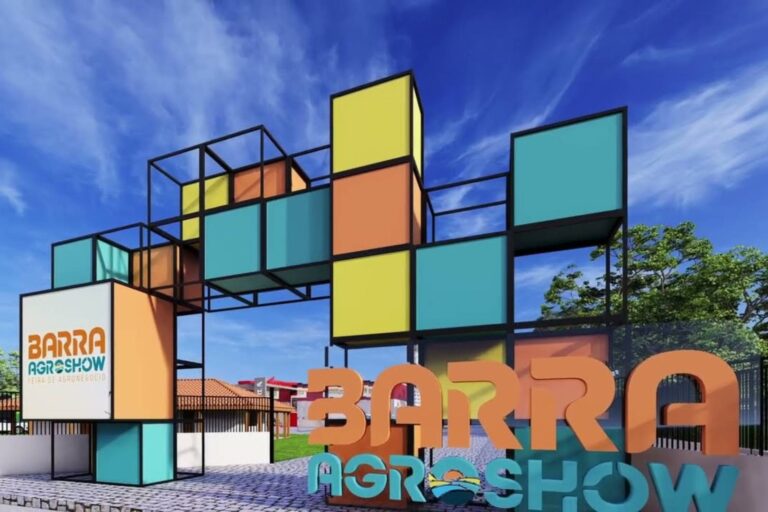These methods allow us to preserve ideal genetics and ensure consistency in yield and quality. At Peirot, these processes are essential to increase our productivity, driven by innovations in sustainable farming in the unique semi-arid region of Barra, Bahia.
What Is Cloning in Agriculture?
Cloning is the process of producing genetically identical plants by propagating from a parent plant. In cacao, this often means taking cuttings—branches or buds—from a high-performing cacao tree and using them to grow a new tree that carries all the same top / canopy / cultivar characteristics.
Why does this matter? Because cacao trees are genetically diverse when grown from seed. A single pod contains seeds that could grow into completely different trees. With cloning, we preserve the exact genetic makeup of a tree known for its flavor, disease resistance, or productivity.
Understanding Grafting
Grafting, is a technique used as part of cloning. A farmer selects a hardy, vigorous rootstock, often from a local variety adapted to the soil and climate. A high-yield cacao variety is then grafted on to this selected rootstock.
The result? A hybrid tree that combines the best of both worlds: a strong, resilient tree which excels in its capabilities to cope with the soil and the weather, while producing larger yields of high-quality cacao.
Of course, you can graft plants together for additional reasons such as disease and pest resistance. In fact, the Brazilian cacao industry nearly died completely when the Witch’s Broom disease spread rapidly. Resistant strains of cacao were identified and grafted to preserve the less tolerant varieties. This was also the case with French grape vines that were saved by American root stocks.
Why It Matters in Bahia
Bahia’s cacao-growing regions, especially the inland areas like Barra where Peirot operates, present specific challenges: high heat, low rainfall, and sandy soil conditions. As cacao originated from the within the lush environment of the Amazon, some varieties struggle in a semi-arid climate.
That’s where hybridization through grafted trees becomes crucial. By carefully selecting and propagating varieties that are both resilient and productive, we increase our chances of long-term success. For example:
- Drought-resistant rootstocks help seedlings survive in dry spells.
- High-yield clones ensure productivity even in semi-arid conditions.
- Disease-tolerant strains reduce reliance on chemical treatments and promote ecological balance.
Our Approach at Peirot
Working with local vendors and our expert cacao consultants, we start by identifying cacao trees that perform exceptionally well in our region: those that produce large, flavorful pods and show strong resistance to local pests or fungal issues. Cuttings from these trees become the base of our cloning strategy.
Next, we match these cuttings with rootstocks that thrive in Barra’s semi-arid soil. Our grafting process is precise and carried out by trained agricultural technicians, many of whom are from the local community and understand the land deeply.
This process not only boosts yields and quality but allows us to grow cacao in areas traditionally considered too dry or challenging for this crop. It’s part of our long-term strategy to make cacao farming more sustainable and adaptive to climate change.
We are starting with the available root stocks and varieties, and we will continue to innovate towards the future with new hybrids.
These techniques aren’t just about maximizing output, they’re about building a better, more sustainable system. Consistency in quality helps us meet the growing demand for traceable, high-grade cacao from ethical sources. Environmental resilience reduces the risk of crop failure due to drought or disease. Less reliance on chemicals aligns with our goals for ecological stewardship and consumer safety.

Beyond Productivity: Why Cloning and Grafting Matter
When we talk about cloning and grafting cacao plants, it’s not just about preserving what works, it’s about creating what’s next. Virtually every major fruit crop has diversified into cultivars with targeted characteristics. Apples, for example, have distinct varieties for cooking, eating fresh, drying, or juicing. Grapes, bananas, and even citrus fruits have followed the same path.
Cacao, on the other hand, remains comparatively underdeveloped. Many of the world’s cacao trees today are still based on broad, undifferentiated lines. There has been limited progress toward precision breeding. In a sense, cacao breeding is still operating nearly a century behind the curve.
That’s changing. And cloning is a major driver of this shift.
Why We Clone and Splice Cacao
At Peirot, cloning and grafting offer a way to accelerate the adoption of superior plant traits. In addition to disease resistance and boosting yields, we’re targeting complex and commercially valuable traits like:
- Higher protein content: Ideal for emerging nutrition-forward cacao products.
- More sugar per pod: For sweeter pulp or flavor-forward fermentations.
- Precocity: Earlier fruiting cycles mean faster returns and more resilient agricultural models in our semi-arid conditions.
Splicing and cloning make it possible to take these high-performing phenotypes and multiply them across entire groves, creating consistency, efficiency, and opportunity.
Matching the Plant to the Purpose
Ultimately, the future of cacao breeding will involve matching specific cultivars to specific market goals. These will included everything from high-end dark chocolate to pulp beverages, cosmetic ingredients, and nutritional supplements. With climate challenges on the rise and buyer expectations evolving, we can’t afford to leave that potential untapped.
Hybrid cacao, selected for both environmental resilience and end-product quality, represents a leap forward. It’s about planting not just for yield, but for purpose.
Local Knowledge Meets Innovation
While cloning and grafting have been used in agriculture for centuries, what makes our approach unique is how we combine these proven techniques with local knowledge and regional innovation. For example, we pair our hybrid cacao trees with smart irrigation systems and organic fertilization practices suited to the dry environment.
We also collaborate with regional agronomists, universities, major cacao companies and suppliers to test new rootstocks and cultivars, monitoring plant health over time. It’s a living, evolving process—always seeking the best balance of performance, sustainability, and environmental respect. With trees, this process is more deliberate and proceeds slower than vegetables – it can take years to identify and curate new varieties for specific needs.
A Future Rooted in Resilience
As global demand for chocolate increases, so does the need for sustainable, climate-smart cacao farming. Techniques like cloning and grafting are no longer optional—they’re essential.
At Peirot, we are at the forefront of the latest developments in cacao farming. We see each grafted tree as a symbol of possibility: a way to grow cacao where others might not, and a tool to ensure that future generations can continue to cultivate this incredible crop.
We’re proud to stand at the intersection of tradition and innovation, preserving the rich heritage of cacao while preparing for tomorrow’s challenges.




